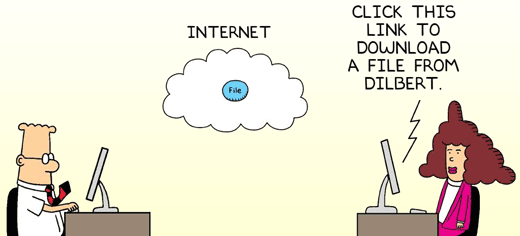How to make email workflow mo' better for you
Email needs a better PR agency. We all use it; even Dilbert. We use it for everything.
If you listen to tech pundits, however, email has died a thousand deaths. It sucks at everything. Every other day, a startup has built an app that is yet another email killer.
If email was a person, she would give out this newsflash:
Reports of my demise are greatly exaggerated.
Indeed, email is here to stay. Over 205 billion emails are sent everyday, and growing.
In the workplace, it has been a tireless workhorse. It does the heavy lifting for everything from project management to document editing.
One area where email may be losing usage is conversation, at least for millennials.
Instant messaging apps like WhatsApp, SnapChat, and Wechat have proven to be the superior form of personal communication; while Slack and Hipchat are the early winners for team messaging.
One area where email is unbeatable — file transfer.
Email is used across organizations, across the globe, and across generations (my mom and eight year old son use email), and across systems (any device, any OS).
Email is the lingua franca of internet communications.
Nothing can beat email for how easy, familiar and flexible it is to send files to anyone, anywhere and on any device.
The problems with email come after the transfer is made.
Working with file attachments is clunky
This should be familiar to anyone who uses email. I can safely assume that includes you.
Everyday, you get a lot of emails. You may open some, and ignore some others. Some emails may include an attached file, and some don’t. When you do want a file attachment, you must download it. You may or may not know where it was downloaded to. Then you forget about it.
After a few months and years of this, you have effectively created a Black Hole that sucks in every email attachment. There are files that are important to you, buried in your inbox.
Accessing file attachments, and then finding what you want when you want them, have become recurring pains-in-the-arse.
Making a better email workflow
Odrive has an awesome integration with Gmail. With over 1 billion monthly active users, you are likely a Gmail user.
odrive has eliminated the problems of accessing, finding and organizing file attachments.
Instead of having to download file attachments, you can directly access them from your desktop in folders organized by “Recent”, “Contacts”, and “Labels”. (How these work and may fit into your workflow are discussed further below.)
This provides you with automatic organization of the files that are important to you, without you having to decide where to download them. Automatic is good, right?
You can now find the file attachments you are looking for, when you want them — on your desktop.
Recent. odrive captures in one folder all your file attachments from the last month. For most people’s daily workflows, this will be the most useful way to find files. It’s a proven fact that our most useful files usually comprise of the most recent vintage.
Contact. odrive also organizes your file attachments, per sender. Chances are, you work with roughly the same group of individuals at any one time. As this changes, from time to time and project to project, organizing by sender is a great way to find historical files.
Labels. Gmail allows you to tag files with “labels”. There are some pre-set labels, but you can also create new, customized labels.
odrive creates folders consisting of emails that have been tagged by your labels. This is a great way to organize what is important to you across email topics, across conversations, and across users.
This is email tricked out with odrive. This is how email should be.
Vive l’email!
Email has endured a bad rap, even as it labors on as the Swiss Army knife of office productivity. It’s not going away so you might as well make email work mo’ better for you.




